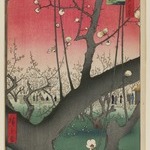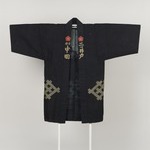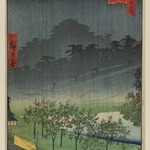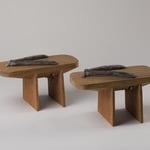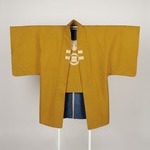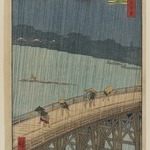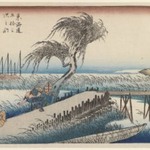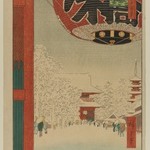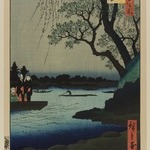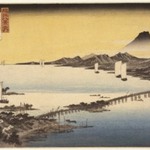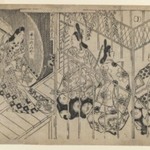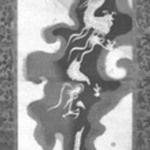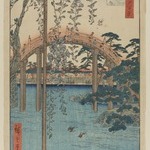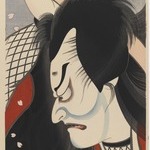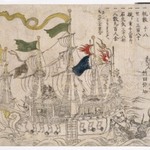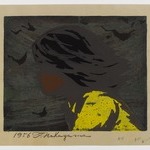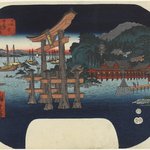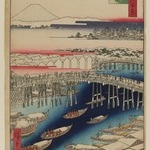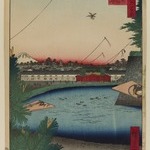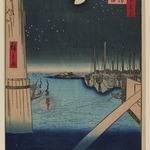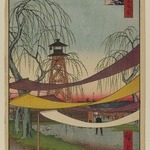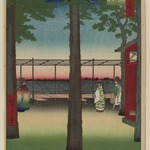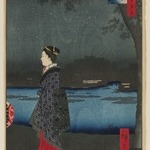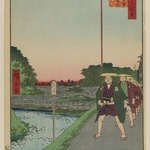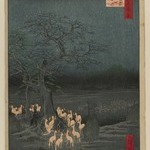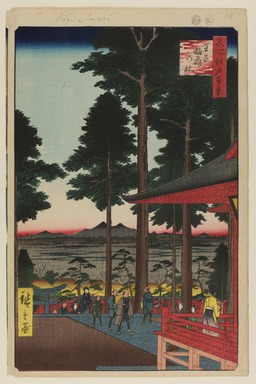
Oji Inari Shrine, No. 18 in One Hundred Famous Views of Edo
Utagawa Hiroshige
Asian Art
White puffy plum blossoms peeping up from behind the teahouses below indicate that it is early spring at Ōji Inari Shrine, the devotional site of Inari, the god of the harvest. Inari worship spread rapidly throughout the rural Kanto hinterland of Edo during the eighteenth century and later moved into the city itself. Because of its antiquity, Ōji Inari Shrine was considered the chief among all Kanto shrines to Inari. Each year in the early spring, farmers and city-dwellers alike gathered there to pray for a good year.
MEDIUM
Woodblock print
DATES
9th month of 1857
PERIOD
Edo Period, Ansei Era
DIMENSIONS
Image: 13 3/16 x 8 5/8 in. (33.5 x 21.9 cm)
Sheet: 14 3/16 x 9 1/4 in. (36 x 23.5 cm) (show scale)



MARKINGS
No publisher's seal visible, probably lost when left edge was trimmed.
SIGNATURE
Hiroshige-ga
COLLECTIONS
Asian Art
ACCESSION NUMBER
30.1478.18
CREDIT LINE
Gift of Anna Ferris
PROVENANCE
Prior to 1930, provenance not yet documented; by 1930, acquired by Anna Ferris of Summit, NJ; 1930, gift of Anna Ferris to the Brooklyn Museum.
Provenance FAQ
CATALOGUE DESCRIPTION
Early spring scene from the Oji Inari Shrine, depicting the white puffs of plum blossoms from the gardens behind the teahouses below; the rice paddies beyond leading to Mount Tsukuba. Inari is a god of the harvest and Inari worship spread rapidly from the mid-tokugawa period throughout the rural Kanto hinterland of Edo, later moving into the city itself. The Oji area was in fact widely known for the foxes (messengers of the Inari god) that made their dens along the wooden ridge. The Oji Inari Shrine was considered the chief along all Knato shrines to Inari and it was near here that all the foxes of the region gathered on New Year's Eve (see plate 118). Oji Inari also sponsored an annual "kite market," since kite-flying was originally a rural New Year's custom for predicting the success of crops. Held on the first day of the Horse in the Second Month, the kite market still thrives today, although the kites are now constructed in the shape of Edo firefighters as amulets against fire. Hiroshige has not shown the kite market in this view, but the undertones are that farmers and city-dwellers alike prayed for a good year.
EXHIBITIONS
MUSEUM LOCATION
This item is not on view
CAPTION
Utagawa Hiroshige (Japanese, 1797–1858). Oji Inari Shrine, No. 18 in One Hundred Famous Views of Edo, 9th month of 1857. Woodblock print, Image: 13 3/16 x 8 5/8 in. (33.5 x 21.9 cm). Brooklyn Museum, Gift of Anna Ferris, 30.1478.18 (Photo: Brooklyn Museum, 30.1478.18_PS20.jpg)
IMAGE
overall, 30.1478.18_PS20.jpg. Brooklyn Museum photograph, 2023
"CUR" at the beginning of an image file name means that the image was created by a curatorial staff member. These study images may be digital point-and-shoot photographs, when we don\'t yet have high-quality studio photography, or they may be scans of older negatives, slides, or photographic prints, providing historical documentation of the object.
RIGHTS STATEMENT
No known copyright restrictions
This work may be in the public domain in the United States. Works created by United States and non-United States nationals published prior to 1923 are in the public domain, subject to the terms of any applicable treaty or agreement.
You may download and use Brooklyn Museum images of this work. Please include caption information from this page and credit the Brooklyn Museum. If you need a high resolution file, please fill out our online application form (charges apply).
The Museum does not warrant that the use of this work will not infringe on the rights of third parties, such as artists or artists' heirs holding the rights to the work. It is your responsibility to determine and satisfy copyright or other use restrictions before copying, transmitting, or making other use of protected items beyond that allowed by "fair use," as such term is understood under the United States Copyright Act.
The Brooklyn Museum makes no representations or warranties with respect to the application or terms of any international agreement governing copyright protection in the United States for works created by foreign nationals.
For further information about copyright, we recommend resources at the United States Library of Congress, Cornell University, Copyright and Cultural Institutions: Guidelines for U.S. Libraries, Archives, and Museums, and Copyright Watch.
For more information about the Museum's rights project, including how rights types are assigned, please see our blog posts on copyright.
If you have any information regarding this work and rights to it, please contact copyright@brooklynmuseum.org.
RECORD COMPLETENESS
Not every record you will find here is complete. More information is available for some works than for others, and some entries have been updated more recently. Records are frequently reviewed and revised, and we welcome any additional information you might have.
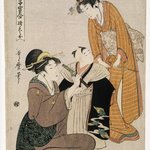
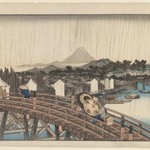
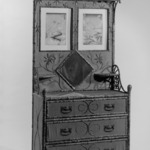

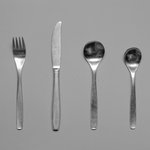

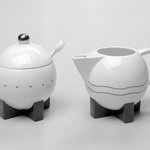

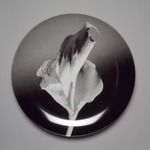

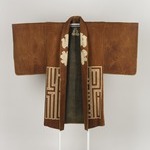
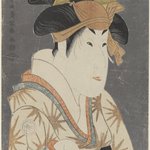

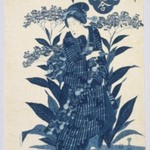
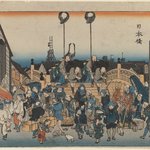
![Kakinomoto no Hitomaro [missing title cartouche: Children Parody the Six Immortal Poets (Tosei Kodomo Rokkasen)]](https://d1lfxha3ugu3d4.cloudfront.net/images/opencollection/objects/size2_sq/82.191_print_IMLS_SL2.jpg)
